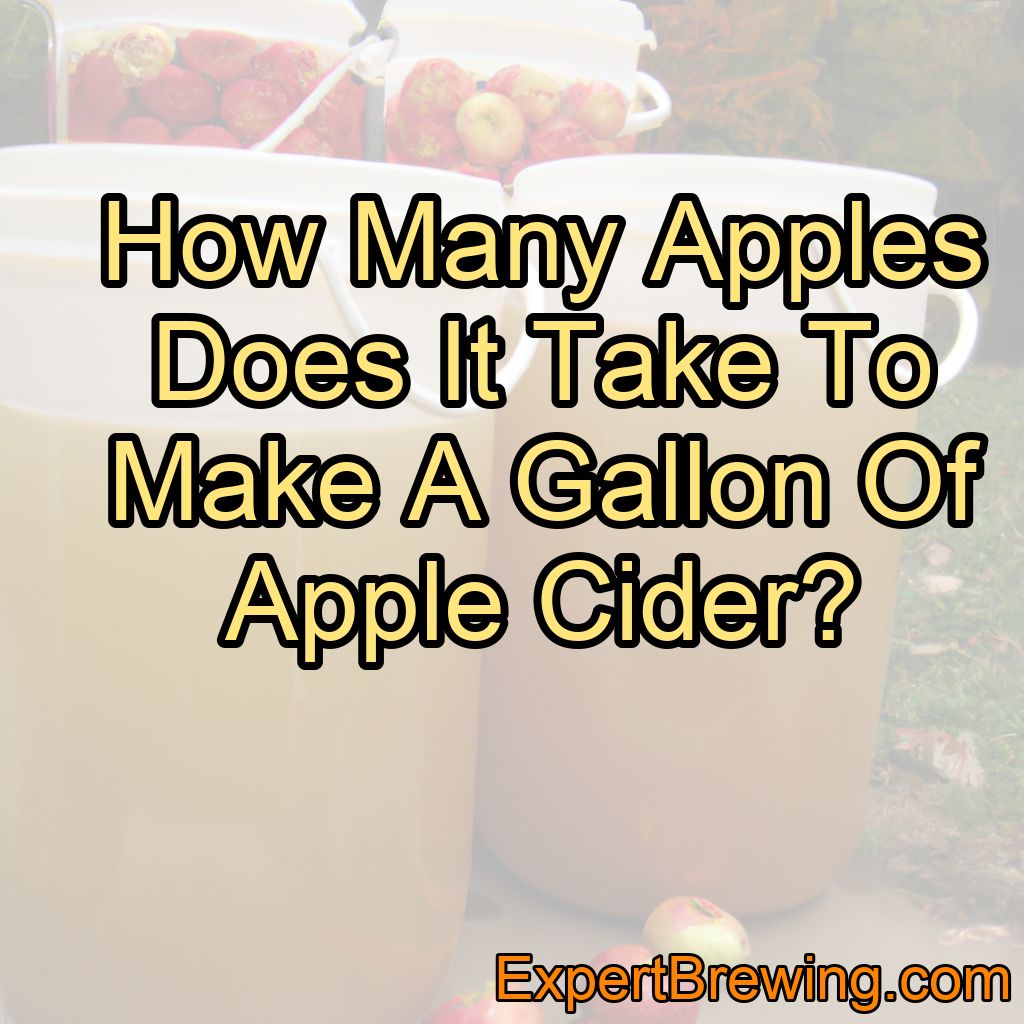Apple cider is a delicious and refreshing beverage that has been enjoyed for centuries. Making apple cider at home is an age-old tradition that many people still enjoy today. As an experienced brewer, I’ve made countless batches of apple cider, and one of the most common questions I get asked is, “How many apples does it take to make a gallon of apple cider?” In this blog post, I’ll explore this question in depth, discussing everything from the types of apples to use, the cider-making process, and even some of the history and traditions surrounding this beloved beverage.
It takes approximately 18 to 20 pounds of apples to make a gallon of apple cider, depending on the variety and size of the apples. This amounts to approximately 40 to 50 medium-sized apples.
Choosing the Right Apples
When it comes to making apple cider, not all apples are created equal. The best cider is made from a blend of different types of apples, each contributing its own unique flavors and characteristics. Here are a few apple varieties that are commonly used in cider-making:
1.Sweet apples– These apples provide a lot of natural sugar, which is essential for fermentation. Some popular sweet apple varieties include Golden Delicious, Fuji, and Gala.
2.Tart apples– Tart apples add acidity to the cider, which gives it a nice balance and complexity. Granny Smith, Jonathan, and McIntosh apples are all good choices for tart apples.
3.Bittersweet apples– Bittersweet apples contain tannins that can create a more full-bodied and complex flavor profile in the cider. Some examples of bittersweet apples are Dabinett, Kingston Black, and Yarlington Mill.
4.Bittersharp apples– These apples are high in both acidity and tannins, making them a great addition to a cider blend. Examples of bittersharp apples include Foxwhelp, Brown Snout, and Golden Russet.
It is essential to experiment with different apple combinations to find the perfect balance of flavors for your cider.
Preparing the Apples
Once you have chosen your apples, it’s time to prepare them for cider-making. First, wash the apples thoroughly to remove any dirt, pesticides, or other contaminants. Then, cut the apples into quarters, removing any stems, leaves, or seeds. There’s no need to peel the apples or remove the cores, as these will all be separated during the cider-making process.
Grinding the Apples
The next step in making apple cider is to grind the apples into a pulp. This can be done using a variety of tools, such as an apple crusher, a food processor, or even a large wooden mallet. The goal is to break down the apples into small pieces, which will make it easier to extract the juice.
Pressing the Apples
Once the apples have been ground into a pulp, it’s time to press them to extract the juice. There are several different types of apple presses available, ranging from small manual presses to large hydraulic ones. The press works by applying pressure to the apple pulp, forcing the juice out and leaving behind the solid apple remains, known as pomace.
When pressing the apples, it’s essential to use a clean, food-grade cloth or mesh bag to contain the pulp. This will allow the juice to flow through while keeping the solids contained.
Fermentation
After pressing the apples, you should be left with a large quantity of apple juice. To turn this juice into cider, it needs to ferment. Fermentation is the process by which yeast converts the sugar in the apple juice into alcohol and carbon dioxide. This can be done using either wild yeast naturally present on the apples or by adding a commercial cider yeast.
To ferment the apple juice, transfer it to a clean, sanitized fermentation vessel, such as a glass carboy or a food-grade plastic bucket. Add the yeast, if using, and seal the container with an airlock to allow the carbon dioxide to escape while preventing any contaminants from entering. The fermentation process can take anywhere from a few days to several weeks, depending on the temperature and the yeast strain used.
Aging the Cider
Once the fermentation process is complete, it’s time to age the cider. Aging allows the flavors to develop and mellow, creating a more complex and enjoyable beverage. Cider can be aged in a variety of containers, such as glass, stainless steel, or oak barrels. The length of time the cider is aged will depend on personal preference and desired flavor profile, but most ciders benefit from at least a month or two of aging.
Bottling and Carbonation
When the cider has reached the desired level of aging, it’s time to bottle it. This can be done using standard beer or wine bottles and caps or corks. Before bottling, you may choose to add a small amount of sugar or carbonation drops to each bottle, which will cause the cider to undergo a secondary fermentation and create a naturally carbonated beverage.
Enjoying Your Homemade Apple Cider
After bottling, allow the cider to rest for a few weeks to allow the carbonation to develop fully. Then, chill the cider in the refrigerator and enjoy it with friends and family. Homemade apple cider is a delicious and rewarding beverage that can be enjoyed year-round, especially during the fall apple harvest season.
Conclusion
In conclusion, it takes approximately 18 to 20 pounds of apples, or 40 to 50 medium-sized apples, to make a gallon of apple cider. Making your own apple cider allows you to experiment with different apple varieties and blends to create a unique and delicious beverage. Here are ten facts about apple cider to remember:
1. It takes about 18 to 20 pounds of apples to make a gallon of apple cider.
2. A blend of sweet, tart, bittersweet, and bittersharp apples creates the best cider.
3. Wash and quarter the apples, but there’s no need to peel or core them.
4. Grinding the apples into a pulp makes it easier to extract the juice.
5. Use a clean, food-grade cloth or mesh bag to contain the pulp when pressing.
6. Fermentation can take anywhere from a few days to several weeks.
7. Aging the cider allows the flavors to develop and mellow.
8. Adding sugar or carbonation drops before bottling creates a naturally carbonated cider.
9. Homemade apple cider can be enjoyed year-round, but it’s especially great during the fall apple harvest season.
10. Experimenting with different apple varieties and blends allows you to create a unique and delicious beverage.
FAQs
How many apples make a gallon of cider?
It takes approximately 36 apples to make one gallon of cider.
How many pounds of apples does it take to make 1 gallon of cider?
It takes approximately 36 pounds of apples to make 1 gallon of cider.
How many pounds of apples make a gallon of cider?
It takes approximately 36 pounds of apples to make one gallon of cider.
How many pounds of apples does it take to make hard cider?
It depends on the recipe and desired alcohol content, but generally it takes about 20-25 pounds of apples to make one gallon of hard cider.
How many apples do I need for 5 gallons of cider?
It depends on the variety of apple and how much juice each apple yields, but on average you will need about 36-40 pounds of apples to make 5 gallons of cider.
How many apples do I need for 5 gallons of hard cider?
It depends on the variety of apple and the desired sweetness and alcohol content of the cider. On average, it takes about 36 pounds of apples to make 5 gallons of hard cider.




